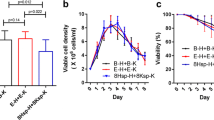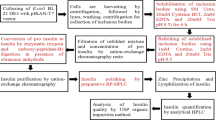Abstract
Human beta-defensin-4 (hBD4) is a cationic 50-amino acid antimicrobial peptide with three conserved cysteine disulfide bonds. It exhibits a broad antimicrobial spectrum. This study describes the synthesis of hBD4 gene, the heterologous fusion expression of the peptide in Escherichia coli, and the bioactive assay of released hBD4. A PCR-based gene SOEing (splicing by overlap extension) synthesis method was used in the synthesis of the hBD4 gene with optimized codons. By constructing the expression plasmid (pET32-smhBD4), high concentration of soluble hBD4 fusion protein (1.9 g/l) can be obtained in E. coli. Further optimization studies showed that the expression system was very efficient to produce soluble target protein, and the solubility of the target protein could attain more than 99% even when the culture temperature was as high as 37°C. The highest productivity (2.68 g/l) of the hBD4 fusion protein was achieved by cultivating the E. coli (pET32-smhBD4) in MBL medium at 34°C, inducing the culture at the mid-exponential phase with 0.4-mM isopropyl β-d-galactopyranoside (IPTG), and collecting the broth after 6-h expression. The soluble target protein accounted for 64.6% of the total soluble proteins, and the mature hBD4 expression level was stoichiometrically estimated to be 0.689 g/l. This fusion protein was then purified and cleaved to get the mature hBD4 peptide that showed antimicrobial activity against E. coli and Pseudomonas aeruginosa.







Similar content being viewed by others
References
Andres P (2002) How do bacteria resist human antimicrobial peptides? Trends Microbiol 10:179–186
Bradford MM (1976) A rapid and sensitive method for the qualititation of microgram quantities of protein utilizing the principle of protein-dying binding. Anal Biochem 72:248–254
Withers-Martinez C, Carpenter EP, Hackett F, Ely B, Sajid M, Grainger M, Blackman MJ (1999) PCR-based gene synthesis as an efficient approach for expression of the A+T-rich malaria genome. Protein Eng 12:1113–1120
Epand RM, Vogel HJ (1999) Diversity of antimicrobial peptides and their mechanisms of action. Biochim Biophys Acta 1462:11–28
Fang W, Xiangming F, Zhinan X, Li P, Peilin C (2004) Fusion expression of human beta-defensin-2 from multiple jointed genes in E.coli. Prep Biochem Biotechnol 34:215–225
Garcia JR, Krause A, Schulz S, Rodriguez-Jimenez FJ, Kluver E, Adermann K (2001) Human beta-defensin 4: a novel inducible peptide with a specific salt-sensitive spectrum of antimicrobial activity. FASEB J 15:1819–1821
Ganz T (1999) Defensins and host defense. Science 286:420–421
Ganz T (2004) Defensins: antimicrobial peptides of vertebrates. CR Biol 327:539–549
Haiqin C, Zhinan X, Naizheng X, Peilin C (2005) Efficient production of a soluble fusion containing human beta-defensin-2 in E. coli cell-free system. J Biotechnol 115:307–315
Hannig G, Makrides SC (1998) Strategies for optimizing heterologous protein expression in Escherichia coli. Trends Biotechnol 16:54–60
Hans PS, Kim KM (2005) Soluble expression of recombinant proteins in the cytoplasm of Escherichia coli. Microb Cell Fact 4(1):1
Horton RM, Hunt HD, Ho SN (1989) Engineering hybrid genes without the use of restriction enzymes: gene splicing by overlap extension. Gene 77:61–68
Hu XY, Shi QW, Yang T (1996) Specific replacement of consecutive AGG codons results in high-level expression of human cardiac troponin T in Escherichia coli. Protein Expr Purif 7:289–293
Johansson AS, Bolton-Grob R, Mannervik B (1999) Use of silent mutations in cDNA encoding human glutathione transferase M2-2 for optimized expression in Escherichia coli. Protein Expr Purif 17:105–112
Kane JF (1995) Effects of rare codon clusters on high-level expression of heterologous proteins in Escherichia coli. Curr Opin Biotechnol 6:494–500
LaVallie ER, DiBlasio EA, Kovacic S, Grant KL, Schendel PF, McCoy JM (1993) A thioredoxin gene fusion expression system that circumvents inclusion body formation in the E. coli cytoplasm. Bio/Technology 11:187–193
Lee JH, Minn I, Chan B, Park Sun C, Kim I (1998) Acidic peptide-mediated expression of the antimicrobial peptide Buforin II as tandem repeats in Escherichia coli. Protein Expr Purif 12:53–60
Li P, Zhinan X, Xiangming F, Fang W, Sheng Y, Peilin C (2004a) Preferential codons enhancing the expression level of human beta-defensin-2. Protein Pept Lett 11:339–344
Li P, Zhinan X, Xiangming F, Fang W, Peilin C (2004b) High-level expression of soluble human Beta-Defensin-2 in E. coli. Process Biochem 39:2199–2205
Makrides SC (1996) Strategies for achieving high-level expression of genes in Escherichia coli. Microbiol Rev 60:512–538
Piers KL, Brown MH, Hancock REW (1993) Recombinant DNA procedures for producing small antimicrobial cationic peptides in bacteria. Gene 134:7–13
Sambrook J, Russell DW (2001) Molecular cloning: a laboratory manual, 3rd edn. Cold Spring Harbor Laboratory, New York
Schagger H and von Jagow G (1987) Tricine-sodium dodecyl sulfate-polyacrylamide gel electrophoresis for the separation of proteins in the range from 1 to 100 kDa. Anal Biochem 166:368–379
SivaKesava S, Xu ZN, Chen YH, Hackett Jams A, Huang RC, Lam E, Lam TL, Siu KL, Wong RSC, Wong WKR (1999) Production of excreted human epidermal growth factor (hEGF) by an efficient recombinant Escherichia coli system. Process Biochem 34(9):893–900
Spanjaard RA, Chen K, Walker JR (1990) Frameshift suppression at tandem AGA and AGG codons by cloned tRNA genes: assigning a codon to argU tRNA and T4 tRNAArg. Nucleic Acids Res 18:5031–5036
Stewart EJ, Aslund F (1998) Disulfide bond formation in the Escherichia coli cytoplasm: an in vivo role reversal for the thioredoxins. EMBO J 17(19):5543–5550
Villaverde A, Carrio MM (2003) Protein aggregation in recombinant bacteria: biological role of inclusion bodies. Biotechnol Lett 25:1385–1395
Weickert MJ, Doherty DH, Best EA, Olins PO (1996) Optimization of heterologous protein production in Escherichia coli. Curr Opin Biotechnol 7:494–499
Xiangming F, Li P, Zhinan X, Jinmin W, Peilin C (2002) Cloning and expression of human beta-defensin-2 gene in Escherichia coli. Protein Pept Lett 9:31–37
Yadwad VB, Wilson S, Ward OP (1994) Production of human epidermal growth factor by an ampicillin-resistant recombinant Escherichia coli strain. Biotechnol Lett 16:882–90
Zhinan X, Gang L, Peilin C, Wong WKR (2000) Factors influencing secretive production of human epidermal growth factor (hEGF) with recombinant E.coli K12. BioProcess Engineering 23(6):669–674
Zhinan X, Fang W, Li P, Xiangming F, Peilin C (2005a) Expression of human beta-defensin-2 with multiple joined genes in Escherichia coli. Appl Biochem Biotechnol 120(1):1–14
Zhinan X, Haiqin C, Naizheng X, Peilin C (2005b) Production of human beta-defensin-2 fused with GFP in E. coli cell-free system. Appl Biochem Biotechnol 127(1):53–62
Zhixia Z, Zhinan X, Li P, Lei H, Xiangming F, Peilin C (2005) Tandem repeat mhBD2 gene enhance the soluble fusion expression of hBD2 in Escherichia coli. Appl Microbiol Biotechnol DOI 10.1007/s00253-005-0212-6
Acknowledgement
This work was financially supported by the National Natural Science Foundation of China (No. 20276066), The People’s Republic of China.
Author information
Authors and Affiliations
Corresponding author
Rights and permissions
About this article
Cite this article
Xu, Z., Zhong, Z., Huang, L. et al. High-level production of bioactive human beta-defensin-4 in Escherichia coli by soluble fusion expression. Appl Microbiol Biotechnol 72, 471–479 (2006). https://doi.org/10.1007/s00253-005-0287-0
Received:
Revised:
Accepted:
Published:
Issue Date:
DOI: https://doi.org/10.1007/s00253-005-0287-0




